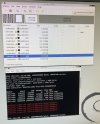Code:
TRY WATCHING AND UNDERSTANDING AND FOLLOWING THIS VIDEO.
https://youtu.be/VR5TP9E9wio
MAYBE YOU WILL HAVE MORE LUCK THAN I DID. I DISCOVERED THIS VIDEO AFTER I REALLY MESSED UP MY SSD WITH TESTDISK.Hello beautiful people.
I messed up. I noticed that my proxmox installation was throwing errors in fdisk -l
The backup GPT table is corrupt, but the primary appears OK, so that will be used.I did the worst possible thing - I found an advice where someone was recommending
sgdisk -e /dev/sda but I misread it.I ran that command on all 3 partitions... sda1 sda2 and sda3
sgdisk -e /dev/sda1sgdisk -e /dev/sda2sgdisk -e /dev/sda3It was 3 am... I was tired. My bad...

Those are the messages I got.
After a reboot all I get is
GRUB LOADING.I was trying to rescue the installation and was reading "recovering from grub failure" from proxmox here https://pve.proxmox.com/wiki/Recover_From_Grub_Failure but when I boot to arch linux live and I run
sudo vgscan and sudo vgchange -ay there is no output and the sudo mount /dev/pve/root /media/RESCUE/ says that the special device does not exist.Rescue boot from Proxmox ISO shows:

/dev/sdb2 can be mounted it contains EFI folder. Other two won't mount or fsck.
I am booted into arch linux live trying to chroot into the installation but the most basic steps are failing.

I don't want to mess with this on my own - I am afraid I will do more damage...
Yes I know... its a bit late for being cautious
Thanks in advance for any help provided.
Kindest regards.
AndrzejL
Last edited:




